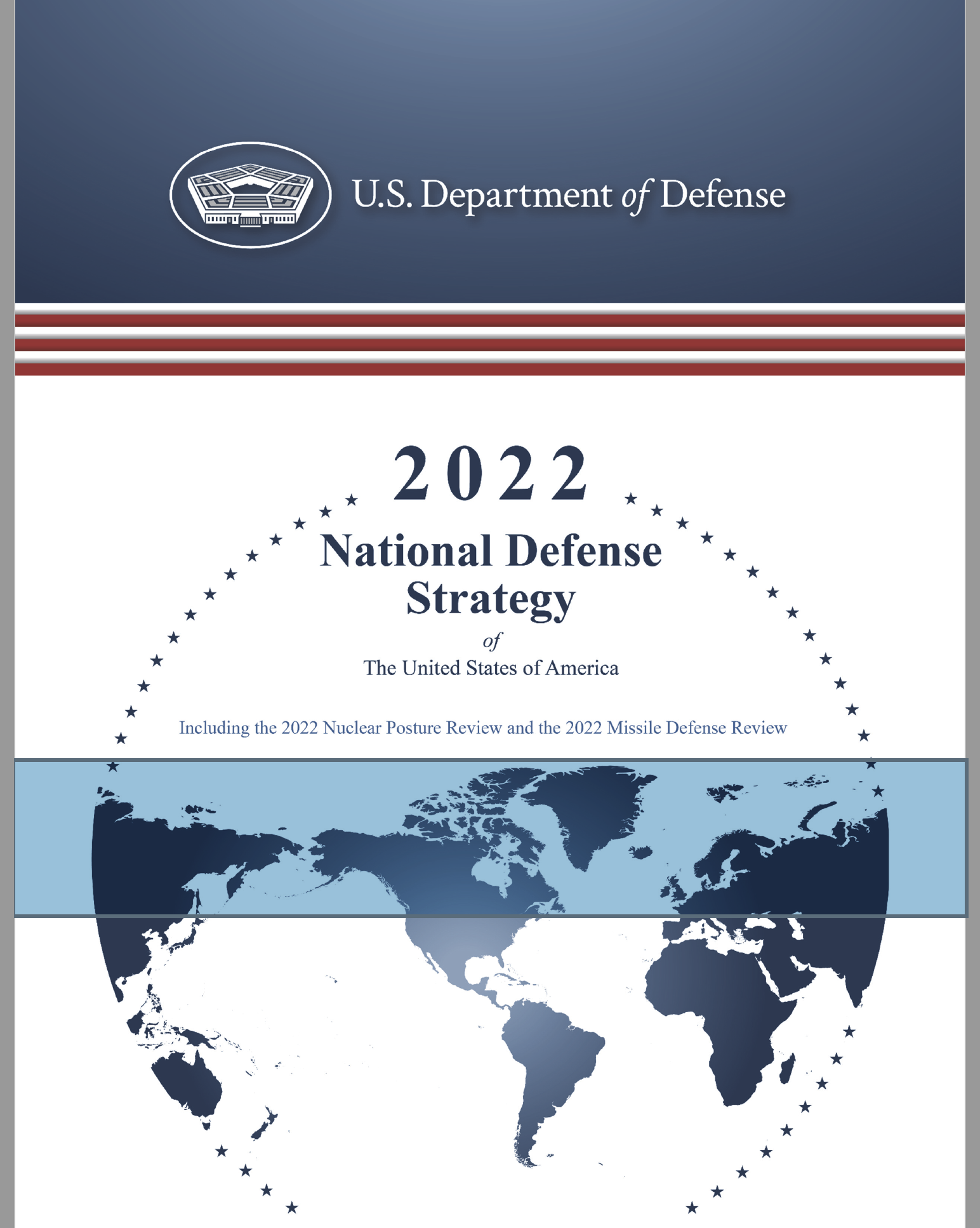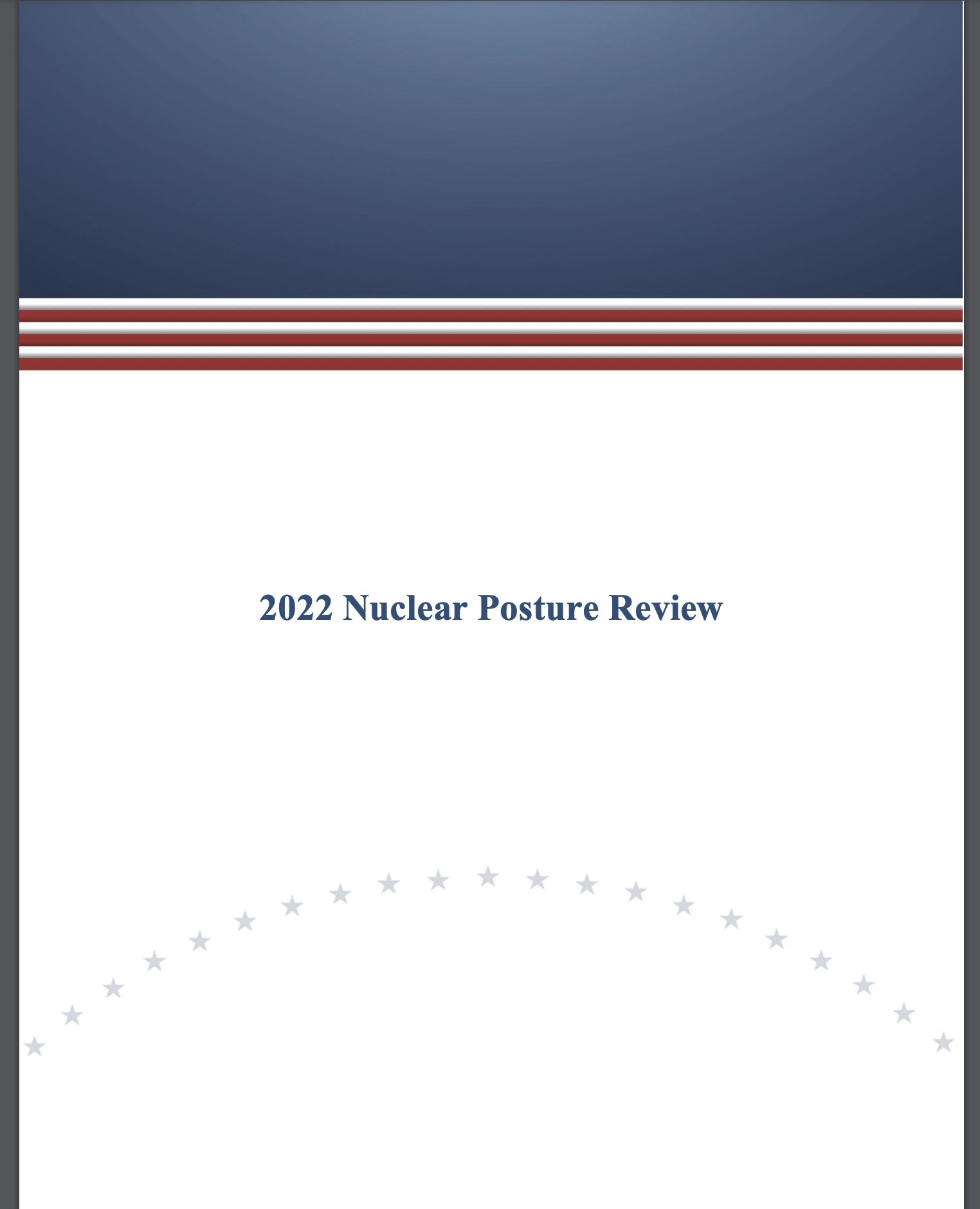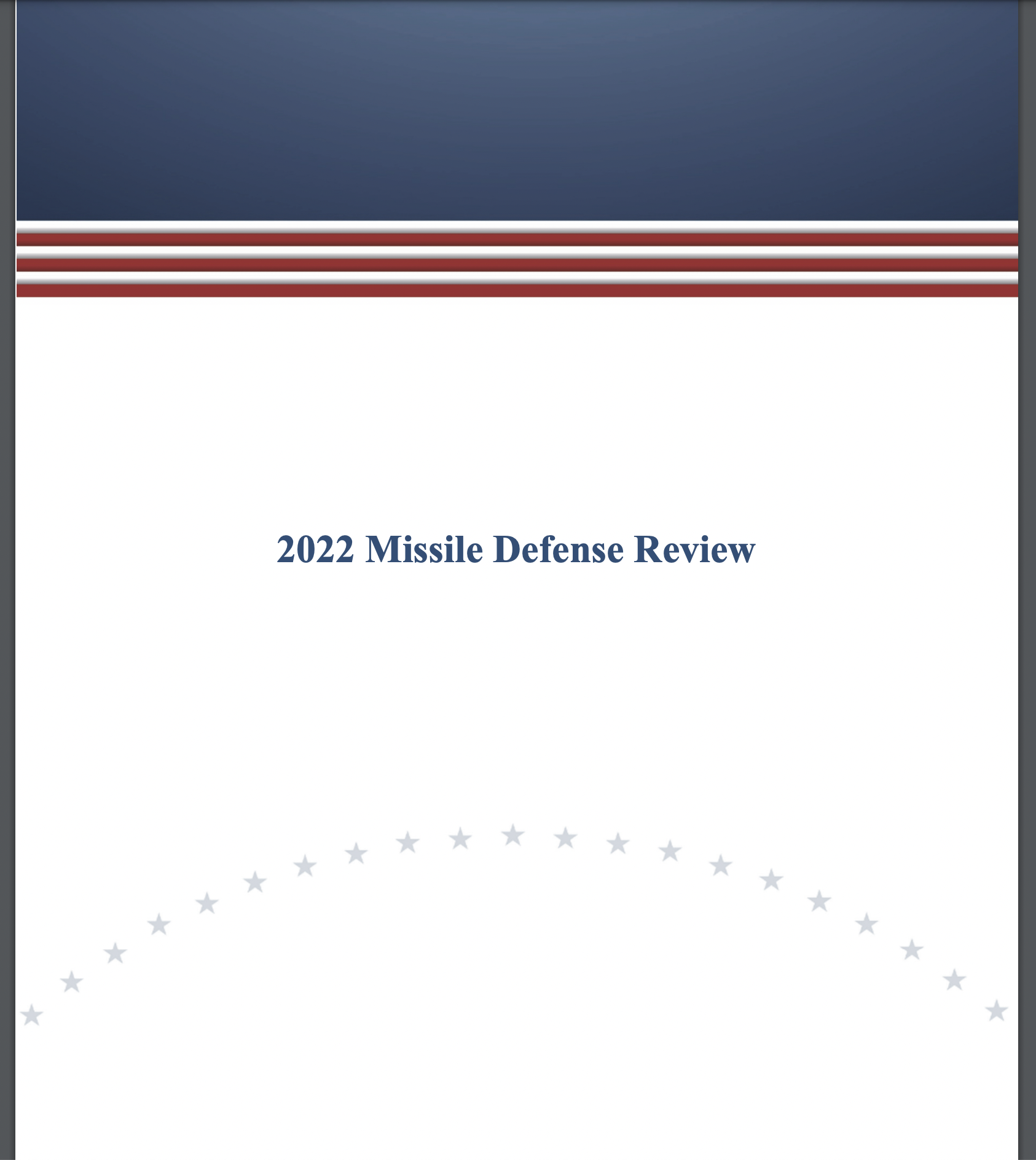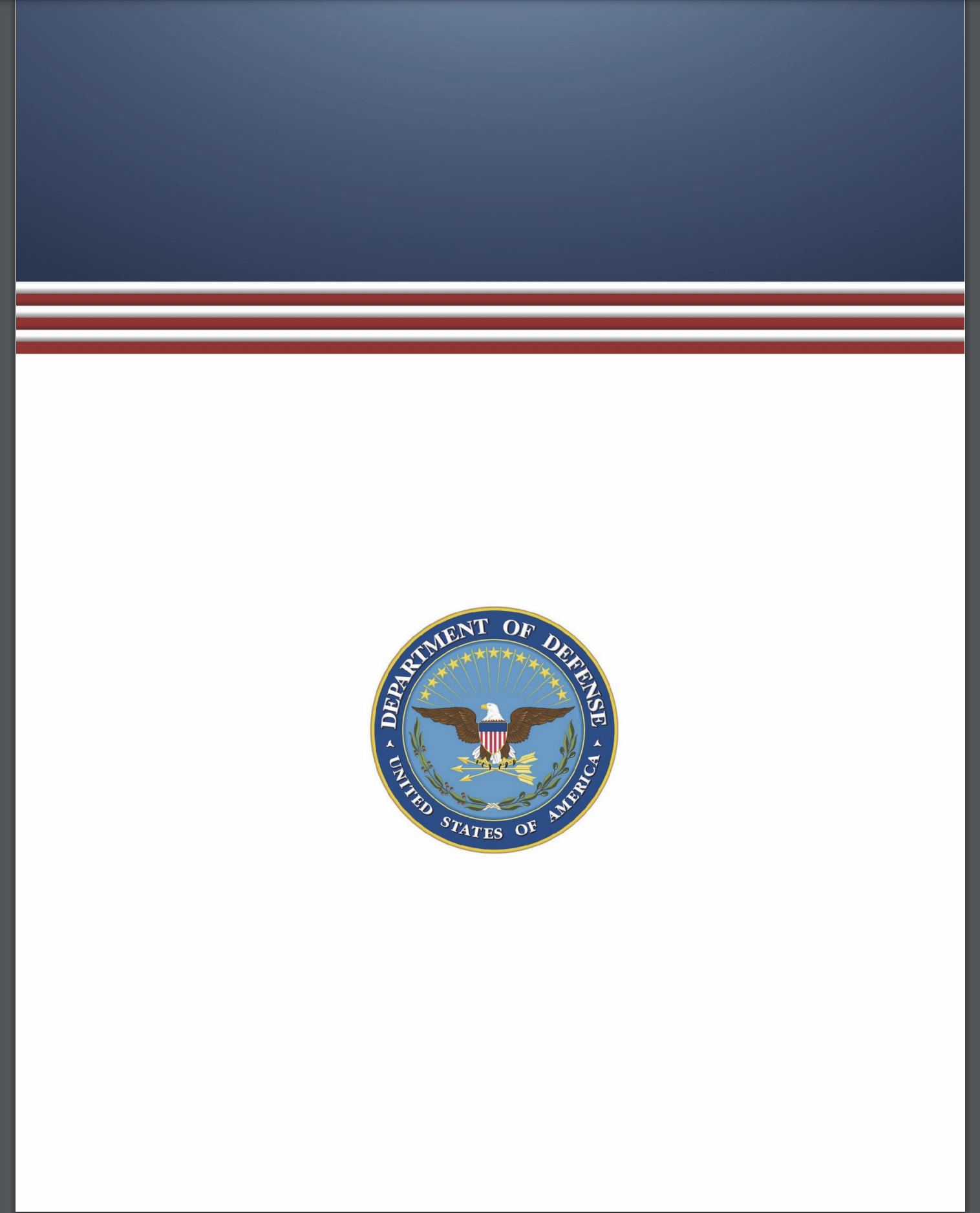Key China Content! From New 2022 National Defense Strategy-Nuclear Posture Review-Missile Defense Review
2022 National Defense Strategy of the United States of America, Including the 2022 Nuclear Posture Review and the 2022 Missile Defense Review (Washington, DC: Department of Defense, 27 October 2022).
First-ever release of UNCLASS Nuclear Posture Review and UNCLASS Missile Defense Review in the same document.
Click here to read the background summary.
NATIONAL DEFENSE STRATEGY
p. iii
The NDS directs the Department to act urgently to sustain and strengthen U.S. deterrence, with the People’s Republic of China (PRC) as the pacing challenge for the Department.
The PRC remains our most consequential strategic competitor for the coming decades. I have reached this conclusion based on the PRC’s increasingly coercive actions to reshape the Indo-Pacific region and the international system to fit its authoritarian preferences, alongside a keen awareness of the PRC’s clearly stated intentions and the rapid modernization and expansion of its military. As President Biden’s National Security Strategy notes, the PRC is “the only country with both the intent to reshape the international order, and, increasingly, the economic, diplomatic, military, and technological power to do so.”
p. vii
INTRODUCTION
The 2022 National Defense Strategy (NDS) sets forth how the U.S. military will meet growing
threats to vital U.S. national security interests and to a stable and open international system. It directs the Department to act urgently to sustain and strengthen U.S. deterrence, with the People’s Republic of China (PRC) as the Department’s pacing challenge. …
p. 2
The 2022 NDS advances a strategy focused on the PRC and on collaboration with our growing network of Allies and partners on common objectives. It seeks to prevent the PRC’s dominance of key regions while protecting the U.S. homeland and reinforcing a stable and open international system. Consistent with the 2022 National Security Strategy (NSS), a key objective of the NDS is to dissuade the PRC from considering aggression as a viable means of advancing goals that threaten vital U.S. national interests. Conflict with the PRC is neither inevitable nor desirable. The Department’s priorities support broader whole-of-government efforts to develop terms of interaction with the PRC that are favorable to our interests and values, while managing strategic competition and enabling the pursuit of cooperation on common challenges.
Even as we focus on the PRC as our pacing challenge, the NDS also accounts for the acute threat posed by Russia, demonstrated most recently by Russia’s unprovoked further invasion of Ukraine. …
We cannot delay. The NSS describes the United States’ agenda for renewal in the coming “decisive decade,” a ten-year window for leadership to tackle our era’s defining challenges. In full accord with the urgency conveyed by the NSS and in support of its broader goals, the Department will move immediately to implement the changes detailed in this NDS, the Secretary of Defense’s preeminent guidance document.
p. 4
SECURITY ENVIRONMENT
Strategic Competition with the People’s Republic of China (PRC). The most comprehensive and serious challenge to U.S. national security is the PRC’s coercive and increasingly aggressive endeavor to refashion the Indo-Pacific region and the international system to suit its interests and authoritarian preferences. The PRC seeks to undermine U.S. alliances and security partnerships in the Indo-Pacific region, and leverage its growing capabilities, including its economic influence and the People’s Liberation Army’s (PLA) growing strength and military footprint, to coerce its neighbors and threaten their interests. The PRC’s increasingly provocative rhetoric and coercive activity towards Taiwan are destabilizing, risk miscalculation, and threaten the peace and stability of the Taiwan Strait. This is part of a broader pattern of destabilizing and coercive PRC behavior that stretches across the East China Sea, the South China Sea, and along the Line of Actual Control. The PRC has expanded and modernized nearly every aspect of the PLA, with a focus on offsetting U.S. military advantages. The PRC is therefore the pacing challenge for the Department.
In addition to expanding its conventional forces, the PLA is rapidly advancing and integrating its space, counterspace, cyber, electronic, and informational warfare capabilities to support its holistic approach to joint warfare. The PLA seeks to target the ability of the Joint Force to project power to defend vital U.S. interests and aid our Allies in a crisis or conflict. The PRC is also expanding the PLA’s global footprint and working to establish a more robust overseas and basing infrastructure to allow it to project military power at greater distances. In parallel, the PRC is accelerating the modernization and expansion of its nuclear capabilities. The United States and its Allies and partners will increasingly face the challenge of deterring two major powers with modern and diverse nuclear capabilities – the PRC and Russia – creating new stresses on strategic stability.
p. 7
III. DEFENSE PRIORITIES
The PRC presents the most consequential and systemic challenge, while Russia poses acute threats – both to vital U.S. national interests abroad and to the homeland. …
In this context, and in support of a stable and open international system and our defense commitments, the Department’s priorities are:
► Defending the homeland, paced to the growing multi-domain threat posed by the PRC;
p. 8
INTEGRATED DETERRENCE
Our competitors, particularly the PRC, are pursuing holistic strategies that employ varied forms of coercion, malign behavior, and aggression to achieve their objectives and weaken the foundations of a stable and open international system.
p. 10
Deterring PRC Attacks. The Department will bolster deterrence by leveraging existing and emergent force capabilities, posture, and activities to enhance denial, and by enhancing the resilience of U.S. systems the PRC may seek to target. We will develop new operational concepts and enhanced future warfighting capabilities against potential PRC aggression. Collaboration with Allies and partners will cement joint capability with the aid of multilateral exercises, co-development of technologies, greater intelligence and information sharing, and combined planning for shared deterrence challenges. We will also build enduring advantages, undertaking foundational improvements and enhancements to ensure our technological edge and Joint Force combat credibility.
p. 14
ANCHORING OUR STRATEGY IN ALLIES AND PARTNERS AND ADVANCING REGIONAL GOALS
The Indo-Pacific Region. The Department will reinforce and build out a resilient security architecture in the Indo-Pacific region in order to sustain a free and open regional order, and deter attempts to resolve disputes by force. We will modernize our Alliance with Japan and strengthen combined capabilities by aligning strategic planning and priorities in a more integrated manner; deepen our Alliance with Australia through investments in posture, interoperability, and expansion of multilateral cooperation; and foster advantage through advanced technology cooperation with
p. 15
partnerships like AUKUS and the Indo-Pacific Quad. The Department will advance our Major Defense Partnership with India to enhance its ability to deter PRC aggression and ensure free and open access to the Indian Ocean region. The Department will support Taiwan’s asymmetric self-defense commensurate with the evolving PRC threat and consistent with our one China policy. We will work with the ROK to continue to improve its defense capability to lead the Alliance combined defense, with U.S. forces augmenting those of the ROK. We will invigorate multilateral approaches to security challenges in the region, to include by promoting the role of the Association of Southeast Asian Nations in addressing regional security issues. The Department will work with Allies and partners to ensure power projection in a contested environment. The Department will also support Ally and partner efforts, in accordance with U.S. policy and international law, to address acute forms of gray zone coercion from the PRC’s campaigns to establish control over the East China Sea, Taiwan Strait, South China Sea, and disputed land borders such as with India. At the same time, the Department will continue to prioritize maintaining open lines of communication with the PLA and managing competition responsibly.
NUCLEAR POSTURE REVIEW
p. 2
Mindful of this imperative, in 2022 the leaders of the five declared Nuclear Weapon States (France, People’s Republic of China, Russian Federation, United Kingdom, United States (P5)) affirmed that a nuclear war cannot be won and must never be fought, and that nuclear weapons should serve defensive purposes, deter aggression, and prevent war. The P5 leaders also reaffirmed their commitment to their disarmament-related obligations under the Treaty on the Non-Proliferation of Nuclear Weapons (NPT) and their intent to strengthen stability and prevent an arms race. Russia’s rhetoric and actions in Ukraine are inconsistent with and undermine this P5 statement. China also has a responsibility as an NPT nuclear weapons state and a member of the P5 to engage in talks that will reduce the risks of miscalculation and address destabilizing military dynamics.
p. 4
THE SECURITY ENVIRONMENT AND DETERRENCE CHALLENGES
The People’s Republic of China (PRC) is the overall pacing challenge for U.S. defense planning and a growing factor in evaluating our nuclear deterrent. The PRC has embarked on an ambitious expansion, modernization, and diversification of its nuclear forces and established a nascent nuclear triad. The PRC likely intends to possess at least 1,000 deliverable warheads by the end of the decade.
While the end state resulting from the PRC’s specific choices with respect to its nuclear forces and strategy is uncertain, the trajectory of these efforts points to a large, diverse nuclear arsenal with a high degree of survivability, reliability, and effectiveness. This could provide the PRC with new options before and during a crisis or conflict to leverage nuclear weapons for coercive purposes, including military provocations against U.S. Allies and partners in the region. …
By the 2030s the United States will, for the first time in its history, face two major nuclear powers as strategic competitors and potential adversaries. This will create new stresses on stability and new challenges for deterrence, assurance, arms control, and risk reduction.
The PRC and Russia are also working to augment their growing nuclear forces with a broader set of kinetic and non-kinetic capabilities, including cyber, space, information, and advanced conventional strike. Each seeks to integrate these multi-domain capabilities to support coercive strategies and enable military campaigns intended to present the Joint Force with operational dilemmas. The PRC and Russia also likely possess capabilities relevant to chemical and biological warfare that pose a threat to U.S., Allied, and partner forces, military operations, and civilian populations.
p. 5
The PRC’s nuclear expansion and the changes this could bring to its strategy present new complexities. In the near-term, we must factor this into our arms control and risk reduction approaches with Russia. We also recognize that as the security environment evolves, it may be necessary to consider nuclear strategy and force adjustments to assure our ability to achieve deterrence and other objectives for the PRC – even as we continue to do so for Russia. Our plans and capabilities must also account for the fact that the PRC increasingly will be able to execute a range of nuclear strategies to advance its goals.
p. 9
Nuclear Weapons in U.S. Defense Strategy. While the United States maintains a very high
bar for the employment of nuclear weapons, our nuclear posture is intended to complicate an adversary’s entire decision calculus, including whether to instigate a crisis, initiate armed conflict, conduct strategic attacks using non-nuclear capabilities, or escalate to the use of nuclear weapons on any scale. Our nuclear deterrent thus undergirds all our national defense priorities, including defending the U.S. homeland, deterring strategic attacks against the United States, our Allies and partners, and deterring regional aggression with emphasis on the PRC and Russia.
p. 11
TAILORED NUCLEAR DETERRENCE STRATEGIES
The PRC is increasing its capability to threaten the United States and our Allies and partners with nuclear weapons. The range of nuclear options available to the PRC leadership will expand in the years ahead, allowing it potentially to adopt a broader range of strategies to achieve its objectives, to include nuclear coercion and limited nuclear first use. We will maintain a flexible deterrence strategy and force posture that continues to clearly convey to the PRC that the United States will not be deterred from defending our Allies and partners, or coerced into terminating a conflict on unacceptable terms. Forces that provide this flexibility include the W76-2 low yield submarine-launched ballistic missile warhead, globally-deployable bombers, dual-capable fighter aircraft, and air-launched cruise missiles. Our intent is to prevent the PRC from mistakenly concluding that it could gain advantage through any employment of nuclear weapons, however limited. The NPR recognizes that as the security environment evolves, changes in U.S. strategy and force posture may be required to sustain the ability to achieve deterrence, assurance, and employment objectives for both Russia and the PRC. …
The PRC and Russia are at different stages in their nuclear weapons development but each poses a major and growing nuclear threat to the United States and its Allies and partners. There is some opportunity to reduce the role of nuclear weapons in our strategies for the PRC and Russia in circumstances where the threat of a nuclear response may not be credible and where suitable nonnuclear options may exist or may be developed. At the same time, we believe that major changes in the role of nuclear weapons in our strategies for the PRC and Russia will require verifiable reductions or constraints on their nuclear forces; otherwise the United States would assume unacceptable deterrence and assurance risks.
p. 15
Strong and Credible Nuclear Deterrence in the Indo-Pacific Region. Our security commitments to Allies and partners in the Indo-Pacific region are steadfast. We recognize growing concerns about nuclear and missile developments in the PRC, North Korea, and Russia, and are committed to strengthening deterrence in ways that are responsive to changes in the regional security environment. Toward that end, we will work with Allies and partners to ensure an effective mix of capabilities, concepts, deployments, exercises, and tailored options to deter and, if necessary, respond to coercion and aggression.
Foundational to this approach is stronger extended deterrence consultation emphasizing a cooperative approach between the United States and Allies in decision-making related to nuclear deterrence policy, strategic messaging, and activities that reinforce collective regional security. Building on the extended deterrence dialogues established over the last decade with the Republic of Korea (ROK), Japan and Australia, and other forums, we will identify pragmatic steps to enhance consultation. This could include periodically meeting at higher levels of seniority and examining options to improve crisis management consultation. An important goal is to identify opportunities for trilateral (United States, Japan, ROK) or quadrilateral (plus Australia) information sharing and dialogue. Relevant lessons-learned from dialogues and consultations should be directly factored into the development of tailored deterrence strategies and operational plans.
The United States will continue to field flexible nuclear forces suited to deterring regional nuclear conflict, including the capability to forward deploy strategic bombers, dual-capable fighter aircraft, and nuclear weapons to the region and globally. We will work with Allies and partners to identify opportunities to increase the visibility of U.S. strategic assets to the region as a demonstration of U.S. resolve and commitment, including ballistic missile submarine port visits and strategic bomber missions. Greater capability integration is an important goal, as well – to better synchronize the nuclear and non-nuclear elements of deterrence and to leverage Ally and partner non-nuclear capabilities that can support the nuclear deterrence mission. In advancing these goals, we view the expertise, capabilities, and resources of our Allies and partners as “force multipliers” for strengthening deterrence.
p. 16
ARMS CONTROL, NUCLEAR NON-PROLIFERATION, AND COUNTERTERRORISM
These policies complement U.S. nuclear policy and force structure decisions and enable us to pursue opportunities to reduce the role of nuclear weapons globally, enhance strategic stability with the PRC and Russia, and reduce the risks of war or escalation during war. …
PRC and Russian actions to expand their nuclear arsenals make mutual and verifiable arms control challenging, but the United States will prepare for engagement and realistic outcomes in dialogues with both governments as this remains in our national security interest. We will seek opportunities to pursue practical steps to advance the goals of greater transparency and predictability, enhanced stability, reduced reliance on nuclear weapons and, ultimately, a world without nuclear weapons. Russia will remain a focus of U.S. efforts given the size, diversity, and continuing modernization of its nuclear arsenal. However, we will need to account for the PRC’s nuclear expansion in future U.S.-Russia arms control discussions.
p. 17
The scope and pace of the PRC’s nuclear expansion, as well as its lack of transparency and growing military assertiveness, raise questions regarding its intentions, nuclear strategy and doctrine, and perceptions of strategic stability. This underscores the need for discussions on practical steps to reduce strategic risks, including steps that that could lay the groundwork for additional discussion of mutual restraints in capabilities and behavior. Although the PRC has been reluctant to discuss these items, the United States remains ready to engage the PRC on a full range of strategic issues, with a focus on military de-confliction, crisis communications, information sharing, mutual restraint, risk reduction, emerging technologies, and approaches to nuclear arms control, among other issues. The United States remains prepared to meet with the PRC in bilateral and multilateral fora while pressing for these discussions to include both sides’ military and diplomatic authorities.
Engagement with the PRC should address its plans for expanding fissile material production to support its growing nuclear arsenal. The PRC should adopt a moratorium on fissile material production or, at a minimum, provide increased transparency to assure the international community that fissile material produced for civilian purposes is fully accounted for and not diverted to military uses. We will make clear to the international community our concerns regarding the PRC’s growing nuclear arsenal, and ensure outreach to the PRC is consistent with our security commitments to allies and partners.
p. 18
Once in force, the CTBT would ban nuclear explosive tests of any yield. Under the CTBT there is no threshold of nuclear yield below which nuclear explosive tests are permissible. If the CTBT were to enter into force, Russia and the PRC would have an obligation to comply with the Treaty’s “zero-yield” standard. The United States will engage with Russia and the PRC, as appropriate, in order to address nuclear test site activities of concern relative to the Treaty, as outlined in the Department of State’s Compliance Report.
MISSILE DEFENSE REVIEW
p. iii
The United States will continue to rely on strategic deterrence – underwritten by a safe, secure, and effective nuclear arsenal, and reinforced by a resilient sensor and Nuclear Command, Control and Communications (NC3) architecture – to address and deter large intercontinental-range, nuclear missile threats to the homeland from the People’s Republic of China (PRC) and the Russian Federation (Russia). As the scale and complexity of the Democratic People’s Republic of Korea (North Korea) missile capabilities increase, the United States will also continue to stay ahead of North Korean missile threats to the homeland through a comprehensive missile defeat approach, complemented by the credible threat of direct cost imposition through nuclear and nonnuclear means.
p. 2
EVOLVING AIR AND MISSILE THREAT ENVIRONMENT
PRC. As outlined in the NDS, PRC efforts and activities to contest the rules-based international order make it the pacing challenge for the Department. Over the past two decades, the PRC has dramatically advanced its development of conventional and nuclear armed ballistic and hypersonic missile technologies and capabilities, through intense and focused investment, development, testing, and deployments. The PRC currently utilizes Russian-developed air and missile defense systems while also pursuing indigenous capabilities that are growing in sophistication. In many areas such as conventional ballistic and hypersonic missile technologies, the PRC continues to close the gap with the United States, and will likely continue to develop and expand its missile capabilities. Increasingly sophisticated and proliferated space-based Intelligence, Surveillance, and Reconnaissance (ISR) networks, and improved Command and Control (C2) systems, have greatly improved the precision and accuracy of missile systems the PRC would employ to deter and counter U.S. forward presence and operations, especially in the Western Pacific region.
p. 5
To address intercontinental-range, nuclear threats from Russia and the PRC, the United States will continue to rely on strategic deterrence – underwritten by safe, secure, and effective nuclear forces – to deter such threats as outlined in the 2022 Nuclear Posture Review (NPR). Ensuring the continued credibility of this deterrent will require investments in missile warning, missile tracking, and resilient NC3 to keep pace with the evolving PRC and Russian threats, and avoid the possibility of evading U.S. sensor networks in a surprise attack.
p. 10
STRENGTHENING INTERNATIONAL COOPERATION WITH ALLIES AND PARTNERS
Indo-Pacific. The pacing challenge posed by the PRC, as well as the growing North Korean missile threat, have magnified the importance of collaborative regional air and missile defense efforts in the Indo-Pacific region. To counter these threats, the U.S. conducts missile defense cooperation with Allies and partners throughout the region, which is strongest with Japan, Australia, and the Republic of Korea (ROK). Our cooperation with these countries strengthens collective regional deterrence and defense efforts while offering assurances critical to the unity of our alliances. Japan, Australia and the ROK practice and signal their respective defensive military capabilities through sustained investment in air and missile defense systems, as well as participation in regular exercises and training with the United States. We will continue to work closely with these Allies and partners, encouraging them to pursue ground- and space-based sensor systems for warning and tracking, and exploring joint opportunities to invest in the cooperative development of complementary IAMD technologies and capabilities such as hypersonic defenses to address advanced and increasingly diverse air and missile threats.









































